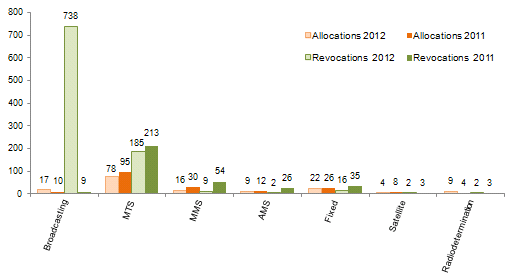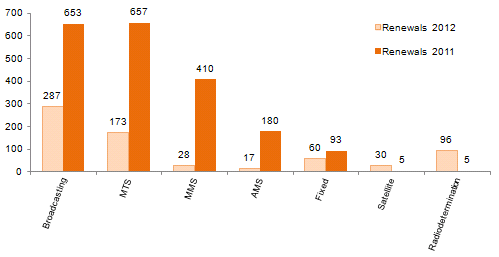This area of activity is focused on issuing network and station licenses for the various radiocommunications services, in accordance with the provisions of Decree-Law no. 151-A/2000 of 20 July, as amended by Decree-Law no. 264/2009 of 28 September.
ICP-ANACOM is responsible for the analysis and processing of the respective licensing procedures, including the assignment of frequencies. The distribution of radio licensing activities by the various radio services during 2012 is presented in the following table:
|
Radiocommunications Service |
New Licenses |
Licence Alterations |
Temporary licences/applications |
||||
|
Station |
network |
Station |
network |
Station |
Network |
||
|
Mobile |
Terrestrial Private Networks |
- |
75 |
- |
166 |
- |
740 |
|
Terrestrial Public networks (TECS)1 |
- |
3 |
- |
84 |
- |
- |
|
|
Terrestrial Trunking Networks |
- |
- |
- |
3 |
- |
- |
|
|
Maritime Private Networks |
16 |
- |
13 |
- |
- |
- |
|
|
Maritime Public networks |
- |
- |
- |
- |
- |
- |
|
|
Aeronautical |
9 |
- |
23 |
- |
- |
- |
|
|
Fixed |
Point-to-point link networks. (Bands below 1 GHz) |
- |
2 |
- |
1 |
- |
1 |
|
Point-to-point link networks. (Bands above 1 GHz) |
- |
16 |
- |
71 |
- |
- |
|
|
Point-Multipoint link Networks (Bands below 1 GHz) |
- |
2 |
- |
1 |
- |
- |
|
|
Studio-Transmitter Networks |
- |
2 |
- |
28 |
- |
10 |
|
|
Satellite Services |
Fixed Satellite Earth Stations |
- |
- |
8 |
- |
- |
- |
|
Fixed Satellite SNG stations |
3 |
- |
5 |
- |
111 |
- |
|
|
Fixed Satellite VSAT Networks |
|
1 |
|
1 |
- |
- |
|
|
Broadcasting |
Radio (Analogue) |
17 |
- |
27 |
- |
31 |
- |
|
Television (Digital) |
- |
- |
- |
48 |
- |
1 |
|
|
Radiodetermination |
Radiodetermination Stations |
9 |
|
27 |
|
- |
- |
|
SAP/SAB Applications |
- |
- |
- |
- |
194 |
||
Source ICP-ANACOM.
The following graphs show licensing activity by service type in 2011 and 2012.
Graph 29. Allocations and revocations of licenses, 2011-2012

Source ICP-ANACOM.
Graph 30. License renewals, 2011-2012

Source ICP-ANACOM.
A total of 2,266 requests were handled as follows (by radiocommunication service):
|
Requests |
Service |
Mobile services |
Fixed |
Satellite |
Temporary |
|
Licensing |
118 |
477 |
525 |
17 |
601 |
|
Miscellaneous requests |
205 |
174 |
63 |
86 |
0 |
|
Totals |
323 |
651 |
588 |
103 |
601 |
Source ICP-ANACOM.
Following the auction conducted to allocate rights of use of frequencies in the 450 MHz, 800 MHz, 900 MHz, 1800 MHz, 2.1 GHz and 2.6 GHz bands (multi-band auction), ICP-ANACOM issued unified titles with the conditions applicable to the Right of use allocated to operators for provision of publicly available terrestrial electronic communications services, with observance of the principle of technological neutrality. Consequently, radio licence titles of the Public Land Mobile Service - global system for mobile communications (GSM) and third generation mobile communications system (UMTS) - have also been reformulated, and in April 2012 TECS radiocommunications network licenses were issued in their place, with each license covering multiple frequency bands allocated to each operator and their respective associated technologies. On the same date, the new electronic licensing application for this service entered into operation.
As such, a new licensing methodology was adopted, which led to a marked reduction in the number of registered stations (from 20,747 to 10,888 at the end of 2012). By operator, the number of stations registered to TMN fell from 8,704 stations to 4,182, the number of stations registered to Vodafone from 6,819 to 3,954 and Optimus 5,224 to 2,752.
This does not mean that there has been a real reduction in the number of stations on the ground, only that there has been a change of designation and concept.
As regards the fixed service, 16 licences were granted and 71 were amended, corresponding to radio link networks of operators, including Vodafone, Optimus, Onitelecom, PTC and RTP, which, taken together, installed 2,020 fixed stations, providing 1010 new point-point links.
Within the scope of the digital television broadcasting service, PTC's network licence was amended in 2012 with the activation of 68 new stations, and, in the case of 48 stations, technical data was amended in the context of optimising SFN functioning on channel 56 in the mainland territory. In addition, a temporary licence was issued and renewed, consisting of three stations.
558 temporary licences were awarded, comprising SNG applications, 194 SAP/SAB applications and 740 MTS private networks.
Graph 31. Distribution of requests for temporary licensing

Source ICP-ANACOM.
There were a further 31 temporary licences granted for FM radio stations, 10 network licenses for studio-transmitter links, one network license for digital television broadcasting and one network license for the fixed service.
Temporary licenses are usually granted for the operation of radiocommunications networks and stations supporting short duration events. In 2012, these included the Portugal Golf Open, the Tour of Portugal cycle race and Estoril MotoGP.
1 Terrestrial Electronic Communications Services (TECS) whose licenses were issued in April.




